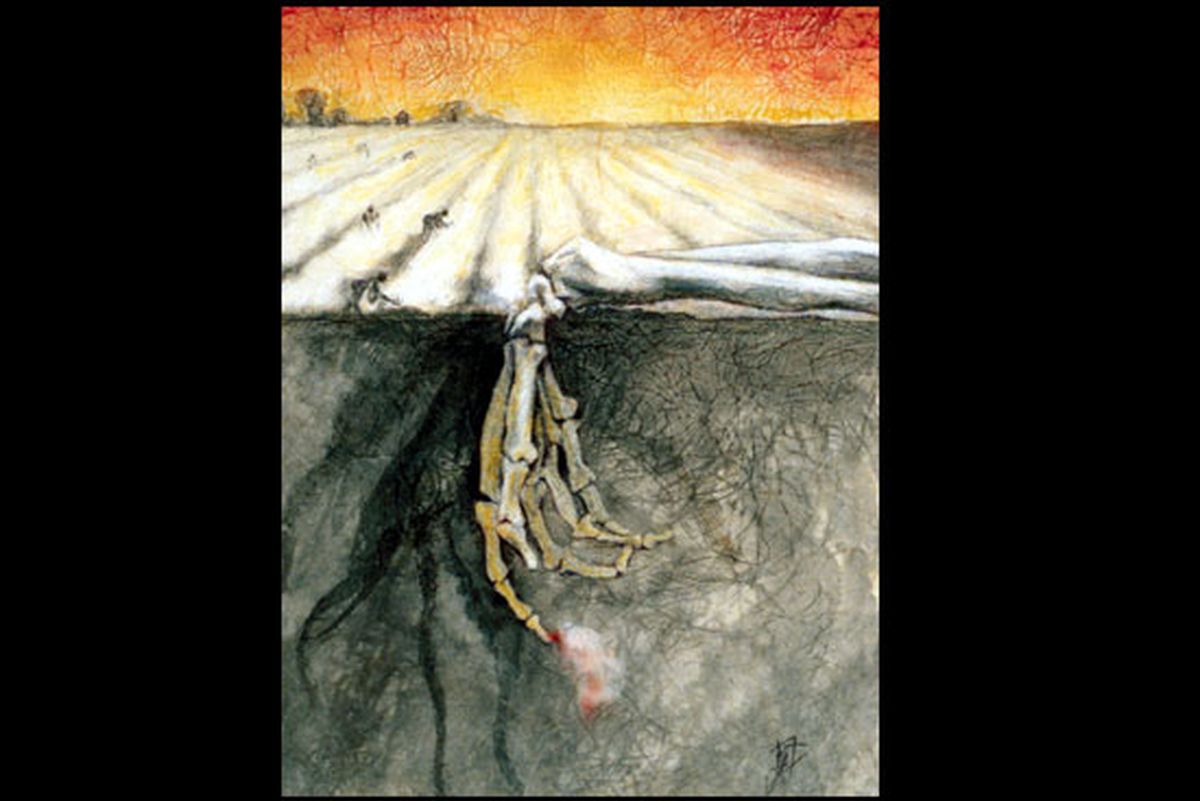EWU exhibition features work from 11 instructors

The best place to get a live pulse on the art world is at the area’s university art schools, where the latest trends are being taught in the newest media.
Eastern Washington University’s School of Art places “a strong emphasis on contemporary art as well as alternative materials and processes,” says Nancy Hathaway, director of the EWU Gallery of Art and assistant professor of art.
“While our students receive instruction in art history, they also are exposed to what is happening in the art world today,” she says.
Faculty artists are producing works in many different mediums and on many scales – from Hathaway’s intimate charcoal drawings on wood, which are only about four inches wide, to Tom Askman’s large, stylized, public sculptures in Spokane, Seattle and across the country.
Pieces by 11 instructors go on display today in EWU’s annual faculty art exhibition.
Roger Ralston, an adjunct instructor and studio tech for sculpture and ceramics, will give an artist lecture today at noon, talking about his public works.
He has two upcoming projects in Spokane: a sculpture at the pending Freya Bridge, and two windvane pieces shaped like butterfly wings that will appear to flutter as they flank the gate to the Liberty Pool. Ralston’s plans are included in the exhibit.
Jenny Hyde’s experimental work pushes boundaries on every edge.
Working with the newest technology in unusual – even extreme – ways, Hyde creates video installations, digital prints, projection and sound.
Since giving up painting as her primary medium, she has been exploring the idea of mark making – the marks humans make with their bodies, including the sounds we produce.
“I’ve been questioning what it is to make things as an artist, analyzing our mark and mark making,” says Hyde, who teaches beginning and advanced digital art, along with a drawing foundation course.
She says her digital prints in the faculty exhibit are “performance oriented,” because the resulting work required her own movement as she recorded her actions.
Hyde used a small, hand-held photo scanner to scan her entire body in “Body Scan,” a life-size, 24- by 66-inch digital print.
Her body is distorted and obscure, appearing as if submerged in water, yet it’s still evocative and recognizable as a human figure. The large, powerful work exudes both motion and emotion.
In “Salt Lick,” Hyde poured salt on top of the scanner bed, then used her tongue, licking the salt to make marks.
Chris Tyllia’s series of crystals, rocks and minerals is amazingly lifelike; it’s hard to imagine that they were created in a kiln. Some of his works include actual grown crystals on the surfaces.
He says it took him a long time to begin making the geological series because he questioned, “Why make something that already exists?… The big question that comes up for me is authorship.
“My focus in graduate school was defining that line between art and science,” says Tyllia, who thinks of himself as more of a facilitator and an observer than an actual creator.
It is the scientific process that intrigues him: Finding the right materials, the right mixture and firing his pieces at the right temperatures.
“I’m not as interested in the forming of the clay but in the chemistry of the materials and what they do in the kiln,” says Tyllia, who teaches advanced ceramics.
Some of the pieces have little to no clay in them, he says, because “clay as a surface is flat and I wanted some translucency.”
Tyllia builds crucibles from clay, then fills them with various ceramic powders and fires them in a kiln at different temperatures.
He removes the fused masses, breaks them apart, and throws the pieces into a rock tumbler or sand blaster “to reveal the color underneath. The most beautiful part is in the center.”
Rachel Dolezal is an adjunct art instructor at both EWU and North Idaho College.
She also is curator and director of education at the Human Rights Education Institute in Coeur d’Alene, where she recently painted the interior walls with 14 oil portraits, 12 feet tall, of international human rights advocates. Created during 48 straight hours for an exhibit celebrating Human Rights Day, the work has since been painted over.
Dolezal, who is part African- American, explores themes of her mixed-race heritage in her artwork.
“A theme in my work is the black experience,” says Dolezal, who teaches an African and African American Art History course at EWU.
A mixed-media work in the faculty exhibit, titled “Final Passage,” is influenced by her years living in Mississippi. It deals with slavery and “themes of death, pain, the afterlife, and finding rest,” she says.
Dolezal also is exhibiting small, leather high-relief sculptures, inspired by her Sioux Indian heritage. Similar to bas-relief, she pounds and forms deer hide after stretching it over her molds of sculpted figures, creating a timless, Paleolithic look.
Although Elisa Nappa is a ceramics professor, she is exhibiting digital prints.
“I’ve always taken pictures as my own reference to inform the work that I’m doing,” says Nappa, who also is the art department chair.
As in her ceramic work, her digital imagery is about repeating shapes, creating patterns, and symmetry.
The “Pool Waterprints” on exhibit are composed of digital images of swimming pool water cut into small, repeating oval shapes and layered to form large ovals that suggest “pool.”
Placed at different angles, the ovals create a feeling of movement. The water provides a sparkling, reflective, sequin-like effect.
Nappa, who will be exhibiting at the Lorinda Knight Gallery in August, says that she’s been tying more of her artwork into the environment.
The swimming pool depicts the idea of “how humans try to control water for our convenience, but the elusive beauty remains.”